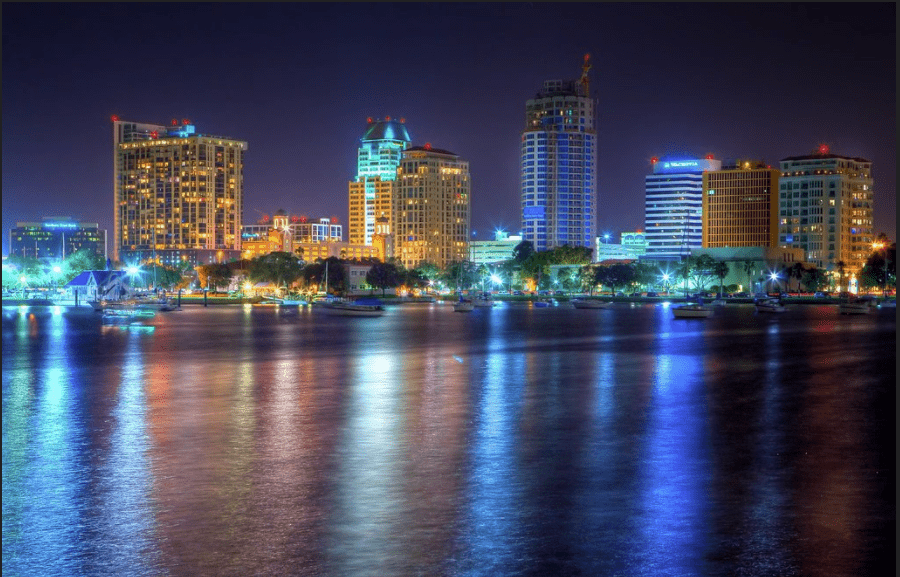St. Pete 2.0 Results: What are we prioritizing as we rebuild St. Pete?

The St. Petersburg renaissance has been in full swing for more than a decade. We’ve excelled in many areas and struggled in others. In our series St. Pete 2.0, we’re partnering with the St. Petersburg Downtown Partnership to explore what lies on the other side of our potential – what will it take to move to the “next level” as a city? Through this series, we’ll dig into specific topics with the hope that you, our thoughtful citizens, will share your insight, experience and wisdom.
COVID-19 cases are on the rise nationwide. Economic instability continues to create stress for business owners and individual residents. And cries for racial equity are echoing across the city from voices demanding change ASAP. St. Petersburg, like so many other cities, is at a crossroads, and the decisions we make now will have a dramatic impact on what the city looks like in the future. These ongoing challenges prompted us to put out a survey asking readers what St. Petersburg should prioritize as it rebuilds.
We used the forum of St. Pete 2.0 to get a sense of what’s most important to the community in terms of public policies and financial commitments. On a scale of one to 10, we asked participants to rank how they prioritize issues ranging from housing to education to the environment. We also asked a few open-ended questions about how St. Pete can build on its strengths, improve on its weaknesses and continue to grow in a way that lifts up all residents. Here’s what we found:
Priority rankings
Respondents were asked to put on their city planning hats and rank their highest priorities for rebuilding the economy with 10 being the highest and one being the lowest. Here’s how the results stacked up:
- Affordable housing
- Housing for all income levels
- Support for startups and entrepreneurs
- Support for higher education
- Job recruitment from employers
- Public safety and security
- Support for K-12 education
- Environmental protections
- Greenspace and outdoor areas
- Support for Small Businesses
What do you see as St. Petersburg’s biggest strengths?
This question elicited a variety of responses, many of which mentioned the city’s friendly vibes, walkability and strong sense of community. And the great weather for most of the year doesn’t hurt, either.
“I moved From Dallas to St. Petersburg just over three years ago,” said Donna Sayers. “What I saw and felt was a diverse, inclusive, inviting, spiritual community. I felt welcome and at home immediately. Seeing all kinds of people who were friendly convinced me I made the right choice to move to St. Petersburg.”
Other respondents praised the city for its culture of creativity and its high level of community support for local businesses and entrepreneurs. In other words, if a rising tide really does lift all boats, St. Pete is certainly operating at full sail.
“We have a community-minded scene of entrepreneurs and artists with individual vision, and a village-like feel to it,” one commenter wrote. “There’s a ton of creativity in a beautiful small city, and the costs are not (yet) so high that one can’t do interesting things.”
Respondent Chris Griffin agreed.
“St Pete’s biggest strength is its creativity and support from the community,” Griffin said. “The new businesses and small businesses have been able to thrive here because the community has always stepped up to support local.”
What do you see as the biggest opportunities for St. Petersburg over the next three to five years and why?
Some people responded to this question with physical improvements they’d like to see, such as redeveloping the Tropicana Field site, cleaning up Central Avenue and beefing up public transportation so more people will use it. Others, however, had more ideological changes in mind, with racial issues and diversity at the forefront of many residents’ minds.
“Race relations. Promoting local businesses and collaborative ventures where ALL people feel welcomed in ALL parts of the city,” Danny E. White commented. “Many Black and Brown people feel downtown St. Pete is off limits as if it’s still 1950. There is a reason why the ‘south side’ is stigmatized and victimized: racism.”
Bekir Konakovic envisions St. Petersburg as a trailblazer for Florida – and the rest of the world – in applying an equity lens to all policies and initiatives.
“Diversity of perspective, inclusivity of voices, and steadfast commitment to ethical integrity and moral decision-making will get us there,” he said.
Another commenter said the city needs to be creative when it comes to issues and inequities.
“How about creating a think tank – open to all residents – where we have dialog on what has been going on with racism and what can be done,” the respondent wrote. “For example – defund the police – what does that mean and could we be a place where new ideas are not only discussed but implemented? I saw officers responding to a woman whose car was broken into – why would you need to send an officer for this? Train civilian investigators in forensics and have them respond to these types of calls.”
Related: St. Pete Police will give up new officers, hire social workers for non-violent calls
What do you see as the biggest issues that are holding St. Petersburg back from achieving our full potential as a community?
A lack of affordable housing options for lower-income residents was a common answer to this question, along with unchecked development and a public transportation system that’s not as strong as it could be.
“Out-of-state developers who are free to rewrite the city in their image without regard to the affordability that St. Pete needs to continue to be a place where interesting people can go to do interesting things is an issue,” one participant noted. “We have a great opportunity in revitalizing Midtown and bringing economic justice to the Black community in St. Pete, and we face huge obstacles if we don’t address it. Affordable housing and a pathetic public transportation system are also serious obstacles.”
And it’s not only lower-cost housing that is a concern.
“There are currently a lot of luxury apartments and there is a lot of talk about having low income housing come in but almost no one is talking about bringing middle income housing to St Pete,” one person commented. “If we want to be a thriving city that attracts young, well-educated individuals, we need to focus on middle-income housing so these young adults have a place to live.”
Several commenters mentioned segregation as an issue that’s holding the city back.
“There’s a legacy of racism, including how segregated by race the city is,” said Pat Fling.
Haley Busch also said that segregation is a problem for St. Pete.
“South St. Petersburg is so close to our thriving downtown, yet visitors to St. Pete never stray south of I-175, which bisected the community to everyone’s detriment,” she wrote.
A few respondents also voiced concerns about the city’s political leadership.
“Allowing the political leaders to make decisions on their own without involvement of communities” could be preventing the city from reaching its full potential, one commenter said.
White said there’s a problem with cliques in city hall.
“People who have been in place in city positions too long and have lost any motivation to be continuously progressive in thought and purpose,” he commented. “Stagnation and complacency are the words I would use to sum this up.”
Who risks being left behind as St. Petersburg continues to rise and how can we ensure that the sun truly shines on everyone in our community?
This question drew a number of thoughtful responses, many of which touched on the need to create opportunities for minorities and low-income residents who may have been left out of policy conversations in the past.
“Minorities and people of color risk being left behind,” said a commenter named Crystal. “Put in place better laws and loans to allow people of color to afford living in St. Pete and help make it great.”
Konakovic said that minorities, including the Black and Brown community and first and second generation immigrants are at risk.
“We must look to uplifting our ‘roots’ in the community and economy,” he wrote. “We must begin to prioritize the well-being of those without means, resources and privileges instead of stakeholders who empirically receive disproportionate attention and service from policymaking.”
That’s why it’s so critical to make a concerted effort to ensure everyone has a voice in community decisions, Sayers said.
“There needs to be representation from all communities on every project,” she commented. “That means people who live in our communities. Ordinary residents who see things that leaders do not know about. It would be a good idea for, particularly white people, to understand the systematic history of why we are in the position we are currently in. There are books, documentaries, movies and many stories from our city that can be accessed. There is so much that has happened through history that is not taught in schools.”
White also touched on schools and said they can and should do better to help raise up St. Pete’s youth.
“Tech jobs are becoming more common while STEM does not seem to be a priority in schools,” he said. “Failing schools seem to be the expected norm with only lip service being paid to address the vicious cycle of under-educated youth. The city is becoming another Miami Beach/Palm Beach/Ft. Lauderdale where implied racism is clearly evident in the have and have-nots landscape.”
Participants viewed a lack of affordable housing affordability as a potential barrier to equity, echoing comments from a previous question.
“I’m very concerned about keeping St. Pete the kind of place where a plumber, a painter, a sculptor and a bass player can all afford to live and work,” one respondent replied. “We need living wages and affordable housing. The free market is unlikely to provide solutions for problems like these, so we’ve got to get clever.”
Natalie G. Stockard observed that since a city-based minimum wage could possibly cause businesses to move or not come to St. Pete at all, “city-supported housing is the next best idea.”
Finally, several responses outlined the need for support for businesses and development beyond the downtown area.
“The Tyrone area seems to be being left behind,” Griffin said. “They are so far from everything that is happening and there doesn’t seem to be anything planned to help connect them to the rest of the city. In general, we need to look at connecting the corners of the city via transportation solutions, connecting the Tyrone area, the Gateway area, the Southside, and Downtown all to one another.”








Shaquille Lashley
July 14, 2020at2:53 pm
Density is the way transit will work. You cannot complain about “overbuilding” and then complain about transit. Density and transit go hand in hand. If you want better transit then you must advocate to completely remove I-375 and I-175 and for them to become multimodal surface level transit corridors. This will spur Transit and development toward Tyrone and South St Pete. You must also advocate for the CHHA density increase. Gentrification will be accelerated if not approved. Look at what’s happening in Miami (Climate Gentrification). It makes sense to increase density in the CHHA because this is where the employment centers are (SMD, Gateway, Innovation District). You want transit to these places and people to get out of their cars, this is how you do it. Increase density where people work and live! It’s simple! Let’s not do things piecemeal.